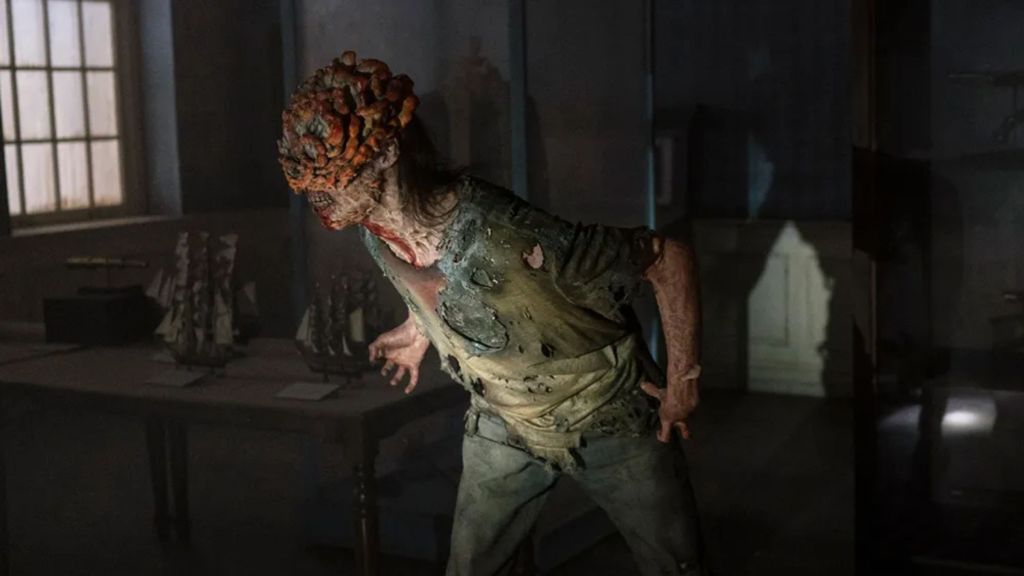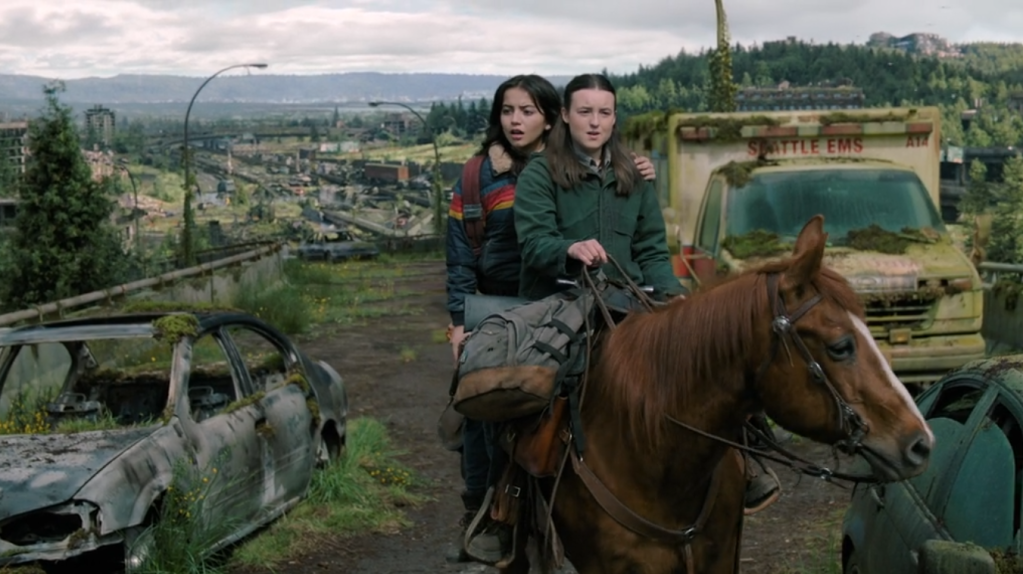HBO’s The Last of Us Season 2 wasted little time plunging viewers back into its brutal world, and Episode 3, “The Path,” sets Ellie (Bella Ramsey) and Dina (Isabela Merced) on a collision course with a new, terrifying location: Seattle. Arriving on the outskirts after their grief-fueled departure from Jackson, the duo finds a city aggressively reclaimed by nature, a hauntingly beautiful yet dystopian landscape of overgrown highways and decaying buildings. The episode quickly establishes that this is an active warzone, as we get glimpses of the heavily armed Washington Liberation Front (WLF), revealed as a formidable force with tanks and marching soldiers. Furthermore, Episode 3 features the unsettling introduction of the Seraphites, a mysterious cult marked by ritualistic scars, found slaughtered in the woods.
Videos by ComicBook.com
The Last of Us show is just beginning to peel back the layers of Seattle’s violent present, hinting at the brutal conflict Ellie and Dina have stumbled into. But for the full, devastating history of how Seattle became this battleground, we need to turn to the source material: Naughty Dog’s The Last of Us Part II.
FEDRAs Iron Grip and the Seeds of Seattle’s Rebellion

The Seattle that players explore in The Last of Us Part II is a city fundamentally reshaped by twenty-five years of apocalypse. Its story begins like many others in 2013, with the catastrophic outbreak of the Cordyceps Brain Infection. The Federal Disaster Response Agency (FEDRA), backed by the military, moved in to establish a Quarantine Zone (QZ), walling off sections of the city to supposedly protect the uninfected survivors. This Quarantine Zone functioned as an authoritarian regime.
[RELATED: What Did Ellie Leave at Joel’s Grave in The Last of Us?]
FEDRA’s control over Seattle was absolute, enforced through checkpoints, patrols, and the constant threat of violence. Surviving meant navigating a system built on scarcity and fear. Essential goods like food and medicine were tightly rationed, forcing many into black markets or smuggling operations just to get by. Mandatory labor details often involved dangerous tasks like clearing infected areas or maintaining failing infrastructure, further fueling the population’s sense of exploitation. In addition, public executions served as a grim warning against breaking the rules, creating an atmosphere of terror rather than security. The remnants of this era are etched into the city’s landscape in Part II, from abandoned military buildings and holding cells to notes detailing desperate attempts to survive or resist FEDRA’s control.
Life under FEDRA was bleak and oppressive, stripping away freedoms and fostering deep resentment among the trapped population. The ubiquitous “F-ck FEDRA” graffiti Ellie finds years later serves as a stark testament to the hatred the military occupation bred. This oppressive environment failed to ensure lasting order and instead actively cultivated the desperation and anger that would inevitably explode into open rebellion.
The Rise of the WLF in Seattle

The Washington Liberation Front, known more commonly and fearfully as the WLF, or the “Wolves,” arose from the conditions created by FEDRA’s collapse. Born from the civilian resentment against FEDRA in the mid-2020s, the WLF began as a grassroots movement founded by ordinary Seattle residents Emma and Jason Patterson. Their initial grievances focused on FEDRA’s brutality, particularly the food shortages and public executions that defined life in the QZ.
While sharing FEDRA as a common enemy, the WLF differed fundamentally from groups like the Fireflies. Unlike the Fireflies, the WLF focused solely on seizing control of Seattle through military force, which aimed for a cure and restoring democracy. Their ethos, captured in the grim motto “May your survival be long. May your death be swift,” reflected a hardened, pragmatic approach to the post-apocalyptic world. As expected, FEDRA quickly branded the WLF terrorists, and the conflict escalated violently.
Peaceful protests gave way to armed struggle, leading to the deaths of the founding Pattersons. Leadership then fell to the calculating and ruthless Isaac Dixon, a brutally effective commander. He unified the WLF, forged new alliances, and ultimately overthrew FEDRA. The WLF captured all FEDRA positions and inherited their substantial military arsenal, including vehicles and weapons. They established their sprawling headquarters in the captured Soundview Stadium (Seattle’s real-world Lumen Field, home to the Seahawks football team), transforming it into a heavily fortified, self-sufficient community with farms, a school, and living quarters.
Initially, Isaac opened the QZ gates to swell their numbers, demanding loyalty oaths in exchange for security. However, liberation quickly curdled into a new form of tyranny. Under Isaac, the WLF became increasingly militaristic, mirroring the oppression they fought against, particularly in their hostility towards the other major group vying for Seattle: The Seraphites.
Fanaticism and the Seraphites

While the WLF rose against FEDRA, another distinct group carved out its own existence in Seattle, the Seraphites. Emerging around the same time as the outbreak in the Queen Anne neighborhood, this community coalesced around a charismatic woman known only as the Prophet. She preached a return to a simpler way of life, rejecting the technology and materialism of the “Old World,” which she believed caused the Cordyceps apocalypse. Her followers embraced a primitivist ideology, living off the land and viewing the infected as “demons.” Their faith was solidified when they refused FEDRA’s offer to join the QZ and survived a period of starvation, viewing it as a miracle. This intense belief system manifested in strict practices: ritualistic cheek scarring (earning them the WLF nickname “Scars”) meant to signify imperfection, mandated hairstyles (shaved heads for men, braided crowns for women), simple robes, a complex system of whistles for communication, and a hierarchical structure led by Elders.
The Seraphites established their primary settlement, Haven, on land that became geographically isolated due to Seattle’s flooding — essentially an island accessible primarily by boat. They built their community using natural materials and cleared the entire island of infected early on, a feat that bolstered their belief in divine protection. The Prophet originally advocated for peace and self-sufficiency. But after Isaac Dixon ordered her capture and execution, turning her into a powerful martyr, the ruling Elders seemingly twisted her teachings. They fostered a more violent, xenophobic interpretation of the faith, justifying extreme brutality against the WLF (like ritualistic hangings) and enforcing rigid internal rules, leading to intolerance towards members who questioned their dogma.
The Seraphites became a powerful example of how ideology can forge resilient communities but also fuel fanatical violence. The execution of the Prophet and the subsequent hardening of the Seraphites under the Elders set the stage for escalating conflict with the WLF, marked by broken truces and increasing brutality from both sides, well before the events of Part II.
A City Drowned and Divided

The Seattle that awaits Ellie is dramatically different from the pre-outbreak city, transformed by decades of decay and conflict. Nature has forcefully reclaimed urban spaces, with lush Pacific Northwest vegetation covering streets, climbing buildings, and creating an eerie fusion of wilderness and ruin. Freeways have collapsed, skyscrapers are hollowed shells, and entire city sections are submerged under water. This extensive flooding is one of Seattle’s defining features in The Last of Us, caused by the failure of tending to management systems (floodgates, pumps, drainage), damage from bombing during the initial outbreak or later conflicts, and the city’s natural propensity for flooding without human intervention.
Iconic Seattle landmarks bear the scars of this history: the WLF fortress stadium, the dilapidated but recognizable downtown buildings like the Courthouse and the Serevena Hotel (Hotel Sorrento), the ornate theatre, the eerily preserved Aquarium, and the Seraphite island itself, crowned by a relocated Space Needle. This transformed landscape, shaped by neglect and violence, forms the backdrop for the simmering war between the WLF and the Seraphites. It’s still unknown how The Last of Us Season 2 will adapt the events of Part II, but the first glimpses of Seattle in the TV show already nod to the city’s complex history in the games.
Do you think HBO’s The Last of Us is doing a good job adapting Seattle and its factions? Join the discussion in the comments!








